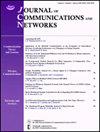物联网中基于区块链和联合学习的网络资源分配方法
IF 3.2
3区 计算机科学
Q2 COMPUTER SCIENCE, INFORMATION SYSTEMS
引用次数: 0
摘要
虚拟网络嵌入(VNE)是解决物联网网络资源分配问题的一种有效方法。但现有的虚拟网络嵌入方法大多是集中式方法,它们不仅给中心服务器带来了过重的负担,还造成了巨大的通信开销。因此,本文提出了一种基于联合学习(DRAM-FL)的分布式资源分配方法,以减轻计算和通信开销,提高网络资源利用率。在使用 DRAM-FL 时,必须解决物联网设备的不可靠特性所带来的安全挑战。因此,我们将区块链引入 DRAM-FL,并提出了一种基于区块链和联合学习(DRAM-BFL)的分布式资源分配方法。在DRAM-BFL中,设计了双链结构以促进节点间可靠的信息交换,提出了节点可靠性评估方法和EPBFT-NRA共识算法以提高VNE的安全性。仿真结果表明,与其他方法相比,DRAM-BFL 在提高系统安全性的同时,还能提高虚拟网络接受率和长期平均收支比。此外,DRAM-BFL 还具有良好的可扩展性,在存在恶意节点的物联网中具有卓越的吞吐量和延迟性能。本文章由计算机程序翻译,如有差异,请以英文原文为准。
Network resource allocation method based on blockchain and federated learning in IoT
Virtual network embedding (VNE) is an effective approach to solve the resource allocation problem in IoT networks. But most existing VNE methods are centralized methods, they not only impose an excessive burden on the central server but also result in significant communication overhead. Therefore, this paper proposes a distributed resource allocation method based on federated learning (DRAM-FL) to alleviate the computing and communication overhead, and improve network resource utilization. When utilizing DRAM-FL, it is essential to address the security challenges arising from the unreliable nature of IoT devices. So, we introduce blockchain into DRAM-FL, and propose a distributed resource allocation method based on blockchain and federated learning (DRAM-BFL). In DRAM-BFL, a dual-chain structure is designed to facilitate reliable information exchange among nodes, a node reliability assessment method and EPBFT-NRA consensus algorithm are proposed to improve the security of VNE. Simulation results demonstrate that, compared with other methods, DRAM-BFL can increase the VN acceptance rate and long-term average revenue-to-expenditure ratio while improving system security. In addition, DRAM-BFL exhibits good scalability, and has superior throughput and delay performance in IoT with malicious nodes.
求助全文
通过发布文献求助,成功后即可免费获取论文全文。
去求助
来源期刊
CiteScore
6.60
自引率
5.60%
发文量
66
审稿时长
14.4 months
期刊介绍:
The JOURNAL OF COMMUNICATIONS AND NETWORKS is published six times per year, and is committed to publishing high-quality papers that advance the state-of-the-art and practical applications of communications and information networks. Theoretical research contributions presenting new techniques, concepts, or analyses, applied contributions reporting on experiences and experiments, and tutorial expositions of permanent reference value are welcome. The subjects covered by this journal include all topics in communication theory and techniques, communication systems, and information networks. COMMUNICATION THEORY AND SYSTEMS WIRELESS COMMUNICATIONS NETWORKS AND SERVICES.

 求助内容:
求助内容: 应助结果提醒方式:
应助结果提醒方式:


